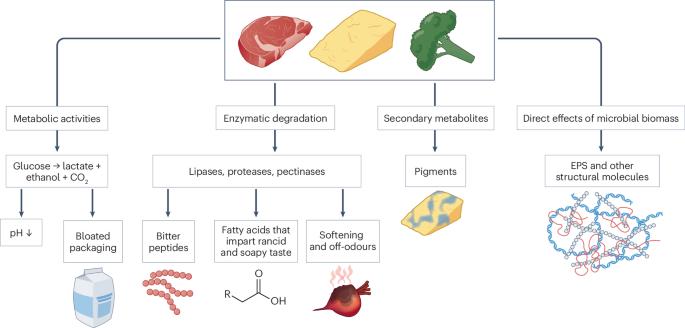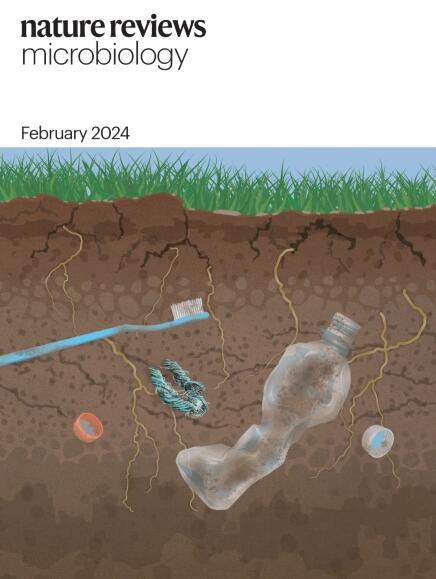食品微生物腐败:影响、致病因子和控制策略
IF 69.2
1区 生物学
Q1 MICROBIOLOGY
引用次数: 0
摘要
食品微生物腐败是造成食品浪费的主要原因,因此也是食品生产和加工对环境可持续性产生负面影响的主要原因。据估计,全球有 15-20% 的食物被浪费掉,根据定义,浪费发生在初级生产和收获之后(例如,在家庭和食品服务机构)。虽然食品腐败的致病因子多种多样,但许多微生物是不同类型食品的主要致病因子。例如,假单胞菌属会导致各种生食和即食食品变质。需氧孢子形成菌(例如芽孢杆菌属、巴氏杆菌属和阿利西环杆菌属)会导致各种食品和饮料变质,而厌氧孢子形成菌(例如梭状芽孢杆菌)则会导致一系列低氧环境下的产品变质。真菌也是重要的腐败微生物,包括在因水活性低或 pH 值低而不易受细菌腐败影响的产品中。减少腐败的策略包括改进对原材料和环境来源中腐败微生物的控制,以及应用杀菌或微生物静态策略(例如,对产品和包装)。新出现的工具(如系统模型和改进的基因组工具)为合理设计系统、工艺和产品提供了机会,从而最大限度地减少微生物对食品的腐败作用。本文章由计算机程序翻译,如有差异,请以英文原文为准。

Microbial food spoilage: impact, causative agents and control strategies
Microbial food spoilage is a major contributor to food waste and, hence, to the negative environmental sustainability impacts of food production and processing. Globally, it is estimated that 15–20% of food is wasted, with waste, by definition, occurring after primary production and harvesting (for example, in households and food service establishments). Although the causative agents of food spoilage are diverse, many microorganisms are major contributors across different types of foods. For example, the genus Pseudomonas causes spoilage in various raw and ready-to-eat foods. Aerobic sporeformers (for example, members of the genera Bacillus, Paenibacillus and Alicyclobacillus) cause spoilage across various foods and beverages, whereas anaerobic sporeformers (for example, Clostridiales) cause spoilage in a range of products that present low-oxygen environments. Fungi are also important spoilage microorganisms, including in products that are not susceptible to bacterial spoilage due to their low water activity or low pH. Strategies that can reduce spoilage include improved control of spoilage microorganisms in raw material and environmental sources as well as application of microbicidal or microbiostatic strategies (for example, to products and packaging). Emerging tools (for example, systems models and improved genomic tools) represent an opportunity for rational design of systems, processes and products that minimize microbial food spoilage. In this Review, Snyder et al. discuss the global impacts of food spoilage, mechanisms and causative agents, and strategies and emerging tools to control microbial food spoilage.
求助全文
通过发布文献求助,成功后即可免费获取论文全文。
去求助
来源期刊

Nature Reviews Microbiology
生物-微生物学
CiteScore
74.00
自引率
0.50%
发文量
149
审稿时长
6-12 weeks
期刊介绍:
At Nature Reviews Microbiology, our goal is to become the leading source of reviews and commentaries for the scientific community we cater to. We are dedicated to publishing articles that are not only authoritative but also easily accessible, supplementing them with clear and concise figures, tables, and other visual aids. Our objective is to offer an unparalleled service to authors, referees, and readers, and we continuously strive to maximize the usefulness and impact of each article we publish. With a focus on Reviews, Perspectives, and Comments spanning the entire field of microbiology, our wide scope ensures that the work we feature reaches the widest possible audience.
 求助内容:
求助内容: 应助结果提醒方式:
应助结果提醒方式:


